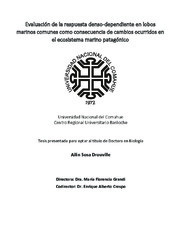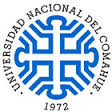JavaScript is disabled for your browser. Some features of this site may not work without it.
Mostrar el registro sencillo del ítem
| dc.contributor.advisor | Grandi, María Florencia | es_ES |
| dc.contributor.other | Crespo, Enrique Alberto | es_ES |
| dc.creator | Sosa Drouville, Ailin | |
| dc.date | 2022 | |
| dc.date.accessioned | 2023-05-30T14:38:08Z | |
| dc.date.available | 2023-05-30T14:38:08Z | |
| dc.identifier.uri | http://rdi.uncoma.edu.ar/handle/uncomaid/17214 | |
| dc.description.abstract | Los mamíferos marinos han sido explotados masivamente durante siglos, causando grandes cambios en su abundancia poblacional. Particularmente, los pinnípedos han constituido una importante fuente de recursos para el hombre. La explotación de estos mamíferos, proporcionó al hombre alimento y abrigo, así como también calor, luz, combustible y material óseo para la confección de diversos elementos. Las poblaciones del lobo marino común*, Otaria flavescens, han sido intensamente explotadas durante los siglos XIX y XX para comercializar su grasa y su piel a lo largo de todo el litoral de América del Sur, generando grandes cambios en su abundancia y afectando la estructura y dinámica poblacional. Particularmente, el stock de Patagonia Argentina, se redujo drásticamente de 440.000 individuos estimados en el período previo a la explotación a tan sólo 20.000 individuos al finalizar la misma, generando una reducción de más del 90% de su abundancia original. Al finalizar la explotación en 1962, la población alcanzó su mínimo de abundancia, luego comenzó a recuperarse lentamente y actualmente se encuentra en crecimiento y expansión poblacional, sin embargo su abundancia representa tan sólo un 40% del tamaño poblacional original. Los abruptos cambios en su abundancia poblacional, proporcionaron un escenario ideal para poder poner a prueba distintas respuestas densodependientes que pueden producirse en poblaciones k-estrategas, como los pinnípedos. El objetivo general de esta tesis es evaluar la respuesta de la denso-dependencia sobre diversos aspectos de la biología del lobo marino común, tales como el crecimiento somático, parámetros reproductivos y su dieta, como consecuencia de los cambios ocurridos en el ecosistema marino patagónico en los últimos 100 años. | es_ES |
| dc.description.abstract | Marine mammals have been extensively exploited for centuries, causing great changes in their population abundance. In particular, pinnipeds have constituted an important source of resources for man. The exploitation of these mammals provided food and cover, as well as heat, light, fuel and bone material for manufacturing of various elements. Populations of South American sea lion (SASL), Otaria flavescens, have been intensively exploited during the 19th and 20th centuries along the entire coast of South America to sell their leather and oil, generating great changes in their abundance and affecting the structure and population dynamics. Particularly, the stock of Patagonia Argentina was severely reduced from an estimated 440,000 individuals in the period prior to exploitation to only 20,000 individuals at the end of exploitation, generating a reduction of more than 90% of its original abundance. At the end of exploitation in 1962, the population reached its minimum abundance, then it began to recover slowly and is currently growing and expanding. However, its abundance represents only 40% of the original population size. The abrupt changes in its population abundance provided an ideal scenario to test different density-dependent responses that can occur in K-strategist populations, such as pinnipeds. The general objective of this thesis is to evaluate the response of density-dependence on various aspects of the biology of SALS, such as somatic growth, reproductive parameters and diet, as a consequence of the changes that occurred in the Patagonian marine ecosystem in the last 100 years. It was analyzed if the abundance changes suffered by SALS had any effect on the shape and size of the skull. For this, geometric morphometric techniques were used on 145 individuals (68 ♂ - 77 ♀) from Patagonia Argentina. The skulls were classified by sex, time period (exploitation, post-exploitation) and decades of birth (1960, 1970, 1980, 1990 and 2000). In each skull, 35 landmarks were digitized in the sagittal plane and the right side of the skull. The results indicated that there were differences in the size of the skulls discriminated by period of time, with the skulls from the exploitation period being smaller than the skulls from the post-exploitation period. In turn, in the current individuals, a decrease in the size of the skull was observed during the last 2 decades analyzed, coinciding with the increase in population abundance in females and males. On the other hand, no significant differences in the shape of the skulls were observed between time periods. These results suggest the existence of a density-dependent response in the somatic growth of O. flavescens from Patagonia Argentina. | es_ES |
| dc.format | application/pdf | es_ES |
| dc.language | spa | es_ES |
| dc.publisher | Universidad Nacional del Comahue. Centro Regional Universitario Bariloche | es_ES |
| dc.rights | Atribución-NoComercial-CompartirIgual 2.5 Argentina | es_ES |
| dc.rights.uri | https://creativecommons.org/licenses/by-nc-sa/2.5/ar/ | es_ES |
| dc.subject | Mamíferos Marinos | es_ES |
| dc.subject | Marine Mammals | es_ES |
| dc.subject | Otaria byronia | es_ES |
| dc.subject | Otaria flavescens | es_ES |
| dc.subject | Lobos Marinos | es_ES |
| dc.subject.other | Ciencias de la Tierra y Medio Ambiente | es_ES |
| dc.title | Evaluación de la respuesta denso-dependiente en lobos marinos comunes como consecuencia de cambios ocurridos en el ecosistema marino patagónico | es_ES |
| dc.type | TesisdePostgrado | es |
| dc.type | doctoralThesis | eu |
| dc.type | acceptedVersion | eu |
| unco.tesis.grado | Doctora en Biología | es_ES |
| dc.description.fil | Fil: Sosa Drouville, Ailin. Universidad Nacional del Comahue. Centro Regional Universitario; Argentina. | es_ES |
| dc.cole | Tesis de Posgrado | es_ES |



